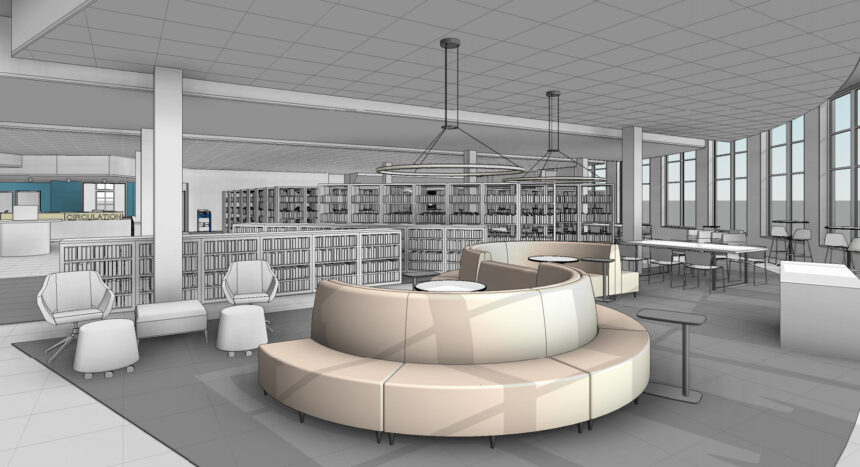A public library’s primary mission has not changed in decades. The exact methods by which a library meets its community’s needs can be a constantly moving target, mainly because of changes in technology.
This is the reasoning behind the planned renovations at the McDonough Public Library just off Hwy 81, east of downtown. At the end of the 20th century, it was contained in a much smaller facility on Hwy 155 (the current home of Henry County Probate Court). In 2001, the current location opened to the public, and since then, it has served an average of 70,000 visitors per year.
A constant task for library officials is finding the balance between the demand for physical products vs. digital products. Henry County library system director Kathy Pillatzki said the five branches in the county still circulate far more actual items with paper pages, to the tune of about a 7-to-1 ratio. The demand is still there, with the exception of reference materials.
“When the [McDonough] building was new, we had a large print reference collection,” she said. “It was a huge section with magazines and encyclopedias and such, as well as a big series of literary criticisms and specialized encyclopedias.”
The explosion of Internet usage at that time has resulted in large reference collections, which can be expensive to print and ship, often becoming outdated by the time they reach the shelves. Library officials in McDonough have scaled back greatly in this area, leaving considerable empty shelf space.
A similar change has taken place with the library’s 26 public computers.
“At one time, you could come almost any time of the day, and every one of those computers would be in use, with a waiting list for the next one available,” said Pillatzki. “What we see now is a large number of people in the library who have their own devices but need our WIFI. They can be there all day studying or conducting business, while at any given time, you might see four or five people on those 26 computers.”
The number of public computers will be reduced, leaving another empty area that can be rearranged so that patrons can still make use of it, but for different reasons. Hence, the renovations.
“Our top priorities will be addressing safety issues along with repurposing underutilized space,” said Pillatzki.
The project is possible because of the $1 million set aside specifically for this purpose. Pillatzki met in 2019 with late commissioner Gary Barham to discuss funding options, and Barham was a key figure in seeing $100,000 for the project placed on the SPLOST V capital projects list. Once voters approved that SPLOST extension, the library system was eligible to apply for and receive a $900,000 state grant. Henry County’s two state senators, Emanuel Jones and Brian Strickland, provided crucial support leading up to the money’s inclusion in this year’s state budget, and the project received unanimous backing from all members of the Henry delegation in the State House of Representatives.
As laid out by Pillatzki, the current timeline includes an expected September date for bidding out the construction portion of the project, with actual work probably starting in December. She could not specify how long it would take, although she speculated on two months or longer to complete the project.
The inside of the library will not be open to the public during the renovation process. Discussions with the architect took place regarding a possible setup with partial work going on in one area of the building while another area remained open, but it was determined that such a plan would result in the overall job taking much longer to complete and being much more expensive.
“We are going to close the library so it can be done more quickly and efficiently, but we will be offering curbside pickup because the staff will have access to library materials,” said Pillatzki. “That will be done at the administrative entrance.”
This will not be new territory for employees or patrons. Library officials became quite proficient at the process of providing curbside service just a few years ago during the COVID-19 pandemic. Pillatzki pointed out that she and her staff realized at the end of the pandemic how such a service could be valuable at other times in the future.
“In addition to being necessary during the renovation, it will be an access point for people with disabilities or someone whose child has fallen asleep in the back seat of the car – if a child is sick and they don’t want to bring them into the library, but they know they will be stuck at home for a few days,” she said.
Upon completion of the project, the library will have newly arranged areas for young adult services, the circulation desk, regular adult services, community gatherings, and virtually every other type of service. One of those areas will be unveiled and named for Barham, who passed away only a few weeks after funding was finalized for this work in which he played such a vital role.
The McDonough branch is actually the oldest in the county, as new facilities have since been built in Fairview, Hampton, Locust Grove, and Stockbridge. All of them were possible in part because of SPLOST dollars.
So, while its staff and administration continue to adapt to changes in patrons’ specific needs, the county library system’s overall goal of serving the community is the same.
“Whether you want to check out a book, or even if you don’t have a library card and just want to come inside and beat the heat,” said Pillatzki. “The library is for everyone.”
By Monroe Roark

